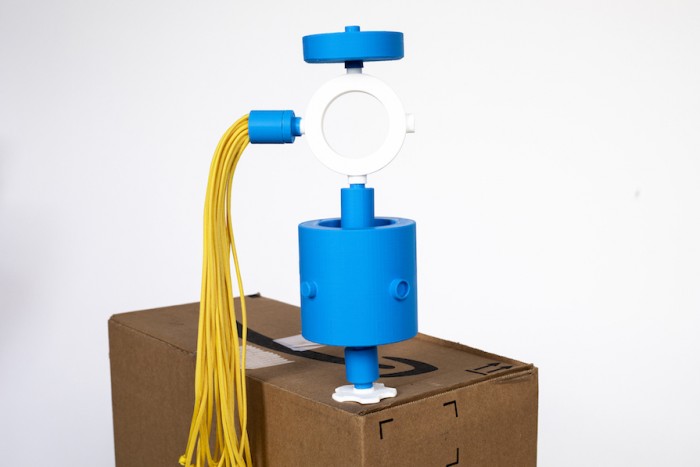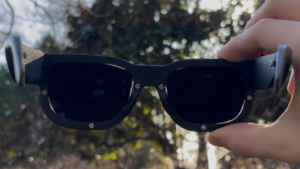A graduate of the Master of Industrial Design course at the Pratt Institute in New York, Danielle Begnaud works to make play a more participatory process for children by co-designing toys. Her project Brain Bridges explores how toy design might change when children are considered partners in the design process, instead of just end users.
Brain Bridges is specifically designed to spark imaginative and creative play. It is composed of a set of generative shapes that allow the children to create using cardboard boxes that they already would have in the home. This involved process helps children to appreciate their own worth, by attributing value to the decisions they make in the process.
Begnaud has been chosen as one of the speakers at antenna 2020. Initiated by Design Indaba and Dutch Design Week, the antenna participants present work that responds to at least one of the Sustainable Development Goals as set out by the United Nations. Brain Bridges contributes towards the fourth goal – quality education for all – by looking at playtime and self-expression as a significantly important part of the development of a child’s mind.
Ahead of this year’s event, which will be happening as part of a fully virtual design week, we chatted with Begnaud about her process, her discoveries and her ethics as a young designer in a complex world.
Design Indaba: What inspired your project?
Danielle Begnaud: What I have always loved about designing for play is children’s immense capacity for imagination. I am so energised by their natural and confident ability for creation — something that seems to fade as we age.
When you are working with children, what is more important – the process itself or the result?
The process. For a designer, the co-design process develops empathy and collaboration skills. But more importantly, the co-design process changes the way children interact with the world around them.
Treating children as equals and as experts in childhood shows them that adults don’t have all the answers, just as children don’t. The process of trying to understand each other and use everyone’s unique knowledge and skills to work through problems shows children that they are knowledgeable, that they have good ideas, that they can collaborate with people that are different from them, and that they can solve problems. They feel respected and confident, and they take that with them into their daily lives.
How do you start the process, and what prompts or tools do you use?
I partnered with KidsTeam at the University of Maryland’s Human-Computer Interaction Lab. KidsTeam is a design team made of children and adults that design using the cooperative inquiry method. This methodology offered structure for workshop activities, prototyping materials, and how to interact with the children.
Actively treating the children as equals and being open about the workshop goals are good places to start. We started every workshop with a snack and casual conversation. Adult participants wore informal clothing, and all team members were on a first-name basis. After snack, adults and children responded to an open-ended ‘Question of the Day’, related to that workshop’s topic. For example – ‘What was the most boring part of your day? Why?’ Then everyone participated in a design activity connected to this question.
This could be a prototyping prompt, for example groups of children and adults designing a boredom machine using cardboard, pipe cleaners, popsicle sticks, EVA foam, etc. Or a rating activity – where children draw objects, places, and activities on magnetic cards and rate them from boring to not boring.
Throughout the workshop, there is constant conversation around what the children are doing and why they feel a certain way.
My partnership with KidsTeam was vital to the success of this project and I cannot thank them enough for their participation, guidance, and enthusiasm.
Did you learn anything totally unexpected during the process or find any practical applications that you didn't foresee?
In our workshops, we used a lot of prototyping materials, like cardboard and VELCRO, to quickly ideate, explain, and build on each other’s ideas. One day, 11-year-old Adrian came up to me and asked if he could bring some of the VELCRO home with him. He said he wanted to use all of the cardboard boxes that he had at his house to continue designing at home. Adrian showed us that the properties that made cardboard such a great prototyping material (wide availability, low price point, sturdy yet malleable, sparks imagination) are the same properties that make it a great a toy.
Did any of the children have any wild, brilliant ideas?
At every workshop! I was constantly amazed at the children’s ideas, many of which guided the design. With some of the wilder suggestions, it was important to me that I tried to understand the root of their idea. What need or problem were they addressing? How is their suggestion solving that need or problem?
When asked to design a boredom machine, Georgia (ten years old) designed a cylindrical machine that was full of soft, silky fabric but also had tape at the bottom. When asked about her material choice, she said, “because you sink into boredom. It looks a little bit attractive because it has some shiny stuff, but then you sort of sink in and get stuck in there.”
Georgia also included a “boredom escape pull” that helped you to eventually get out of boredom if you needed it. Georgia’s design helped us to understand how she falls into boredom accidentally, how she sometimes needs help to get out of boredom, and that this help could come in a physical form.
What made you decide to study design?
Design has been my life-long passion, but I only recently understood it as “design”. Through various mediums, I have always tried to create experiences that give people the opportunity to play. Igniting joy, exploration, and even light-hearted mischief has always been a motivator for me.
So, what is your definition of design?
Gathering information from the world around you, often from disparate disciplines and experiences, and synthesising it into a new reality.
How do you think design can better be used as a tool for good and for change?
Design has huge potential to initiate positive change when it involves community members and user groups in the creative process. The more we ask these people for help, the more we learn from their expertise, and the more impact design will have.
Do you think design is very individual? Just one person’s inspiration?
Designers are constantly absorbing and reinterpreting the world around us. Understanding the status quo created by everyone around you and before you is what makes new ideas possible. To add your own ideas and designs to this status quo and become a part of a conversation that stretches across time and space is an amazing thing. I think it would be a hindrance to try to design in a bubble.
What are your design ethics?
Working on Brain Bridges over the past year has made me a strong advocate for co-design. Inviting other people into your design process can feel like a loss of control — over the process as well as the outcome. Acknowledging a group of people’s expertise and asking for their help is a humbling experience. But it has also been an experience that gives me a lot of hope. After going through this process, I am hopeful that co-design offers a road forward for design through collaboration, respect, and empathy.
Should products always be ‘useful’?
Yes, but maybe not in the traditional way we think about usefulness. I think creating space for rest, reflection, appreciation, daydreaming, and especially play, are useful and crucial functions an object can possess.







